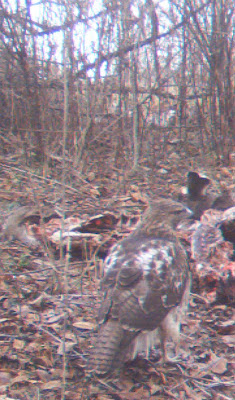Coyotes are quite common in Pocahontas County. We hear them often, see them occasionally, and our sheep-farming neighbors trap and shoot them. I know these creatures are coyotes because people here tell me so, for they are much larger, darker colored, and bolder than the coyotes I knew growing up in western Iowa. I would never have recognized the animals here as coyotes--the first pair I saw trotting down the driveway I took for large dogs.
This makes me wonder whether the difference between the fox-sized animals of western Iowa and the German Shepherd-sized coyotes of West Virginia is due to phenotypic plasticity or to genetic difference, especially hybridization with dogs and/or wolves. I haven't found a definitive answer (and it could a combination of the two causes), but some recent news reports about wolves have got me thinking about the issue again.
Earlier this year, the US Fish and Wildlife Service announced a success story with the Gray Wolf (Canis lupus) in the Upper Midwest.
By the time wolves were protected by the Endangered Species Act of 1973, only a few hundred remained in extreme northeastern Minnesota and a small number on Isle Royale, Michigan. Gray wolves were listed as endangered in the contiguous 48 States and in Mexico, except that in Minnesota they were listed as threatened. Alaska wolf populations number 6,000 to 7,000 and are not considered endangered or threatened.
The wolf's comeback nationwide is due to its listing under the Endangered Species Act, resulting in increased scientific research and protection from unregulated killing, along with reintroduction and management programs and education efforts that increased public understanding of wolf biology and behavior. Wolf recovery has been so successful that the U.S. Fish and Wildlife Service has removed the gray wolf in the western Great Lakes area from the threatened and endangered species list. Today about 3,020 wolves live in the wild in Minnesota, 30 on Lake Superior's Isle Royale, about 434 in Michigan's Upper Peninsula, and at least 465 in Wisconsin.
Subsequently, results of a genetic study were released: Native Great Lakes wolves were not restored. Here's the (very brief) abstract. (The actual article is for paid subscribers only.)
Jennifer A. Leonard, Robert K. Wayne Biol. Lett.
Wolves from the Great Lakes area were historically decimated due to habitat loss and predator control programmes. Under the protection of the US Endangered Species Act, the population has rebounded to approximately 3000 individuals. We show that the pre-recovery population was dominated by mitochondrial DNA haplotypes from an endemic American wolf referred to here as the Great Lakes wolf. In contrast, the recent population is admixed, and probably derives also from the grey wolf (Canis lupus) of Old World origin and the coyote (Canis latrans). Consequently, the pre-recovery population has not been restored, casting doubt on delisting actions.
Surprisingly, more information is available in the November 13 New York Times article, Off Endangered List, but What Animal Is It Now? by Mark Derr.
Amid much fanfare this year, the federal Fish and Wildlife Service declared the western Great Lakes gray wolf successfully recovered from an encounter with extinction and officially removed it from the endangered species list....
But the victory celebration was premature, according to two evolutionary biologists, Jennifer A. Leonard of Uppsala University in Sweden and Robert K. Wayne of the University of California, Los Angeles. The historic Great Lakes wolf...hybridized with gray wolves moving in from Canada, coyotes from the south and west and the hybrids born of that mixing.
Dr. Leonard said...these animals should remain protected...while researchers determine the full extent of hybridization with coyotes, whether it is continuing and whether it threatens to swamp the genetic heritage of the native wolf.
Rolf O. Peterson, a wolf ecologist at Michigan Technological University and the leader of the Fish and Wildlife Service's Eastern Gray Wolf Recovery Team, said it had been known for some time that hybridization between gray wolves and coyotes was happening in the region.
"What's new in this paper," he said, "is that they found no evidence of hybridization with coyotes in the historic samples and no pure historic wolves in the current samples."
....That population today is made up largely of hybrids between the gray wolf and coyote, but some 31 percent of the animals carry genetic material from the native wolf, which appears to no longer exist in pure form. The researchers analyzed mitochondrial DNA, inherited through the mother and often used to distinguish lineages in humans and animals, from 17 early-20th century wolves and 68 contemporary wolves.
I had no idea that there was so much introgression between wolves and coyotes, but it seems that it is the bane of Red Wolf preservation. The Red Wolf Coalition says:
Red wolves and coyotes, especially young red wolves, can look very similar. Coyotes weigh about one-half to two-thirds as much as red wolves and stand approximately 4 inches shorter. In general, coyotes have a much slighter build through the head, chest, legs, and feet.
Red wolves, gray wolves, domestic dogs, and coyotes are capable of interbreeding and producing fertile offspring....By the 1960s the number of red wolves was dwindling, and coyotes had migrated into the Southeast. When the few remaining red wolves were unable to find mates of their own species, hybridization with more abundant coyotes did occur. This hybridization is generally accepted as the final factor that resulted in the near extinction of the red wolf.
Red wolves and coyotes have been hybridizing in northeastern North Carolina and the Service is addressing the hybridization threat with urgency. Initial estimates indicate that the current red wolf population would be unrecognizable as such within 3-6 generations (12-24 years) if the rates of hybridization currently being controlled actually occurred. The Service is partnering with several agencies and universities to conduct research that will allow for better understanding and hopefully successful management of hybridization based on the best available scientific information.
Here are my wolf references, for further reading.





























